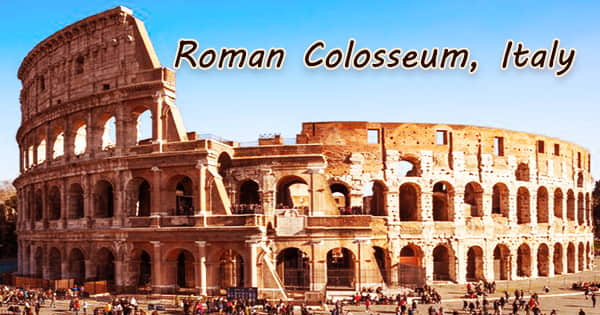The Roman Colosseum, Italy is the largest edifice from Roman times and is one of the most iconic landmarks in the world. Its overwhelming presence in the heart of modern-day Rome is a tribute to the city’s rich past and the Roman Empire’s triumphs. Construction began in 72 under Emperor Vespasian (r. 69–79 AD) and was completed in 80 AD under Titus (r. 79–81 AD), his successor and heir. During the reign of Domitian (r. 81–96), more changes were enacted. In A.D. 80, Titus, Vespasian’s son, inaugurated the Colosseum (/ˌkɒləˈsiːəm/ KOL-ə-SEE-əm; Italian: Colosseo (kolosˈsɛːo)) officially known as the Flavian Amphitheater with a 100-day festival that included gladiatorial combats and wild animal battles. The spectacular arena fell into disuse after four centuries of active usage, and it was exploited as a source of building materials until the 18th century. Unlike earlier amphitheatres, which were almost all excavated into handy hillsides for added support, the Colosseum is a freestanding stone and concrete building with a complex system of barrel and groin vaults with a total size of 620 by 513 feet (189 by 156 meters). The structure’s rising arrangement of columns became the basis of the Renaissance codification known as the assemblage of orders. Three of the arena’s stories are encircled by arcades framed on the exterior by engaged columns in the Doric, Ionic, and Corinthian orders; the structure’s rising arrangement of columns became the basis of the Renaissance codification known as the assemblage of orders. Travertine makes up the primary structural framework and facade, volcanic tufa makes up the subsidiary walls, and concrete makes up the inner bowl and arcade vaults. Visitors arriving from the nearby metro station or rounding a corner for the first time can’t help but be taken aback by its massive size. The structure’s construction began in AD 72, and it remains one of the world’s most popular tourist destinations today. The Colosseum was used for gladiatorial contests and public spectacles such as animal hunts, executions, re-enactments of famous battles, and dramas based on Roman mythology, as well as briefly mock sea battles. It could hold an estimated 50,000 to 80,000 spectators at various points in its history, with an average audience of around 65,000. Despite the fact that two-thirds of the ancient Colosseum has been damaged through time, the amphitheater remains a famous tourist attraction and a symbol of Rome’s long and turbulent past.

The floor of the Colosseum, once the battlegrounds of valiant gladiators, will be restored to its former grandeur, according to the Italian government. This would allow the Colosseum to host cultural and other special events, as well as enabling tourists to imagine what it was like to stand in the midst of the screaming throng. Two famous Roman families, the Frangipane and the Annibaldi, utilized the Colosseum as a church and subsequently as a fortification in medieval times. Lightning and earthquakes, as well as vandalism and pollution, wreaked havoc on the Colosseum. For almost 1,000 years, the site was treated as little more than a quarry, and all of the marble benches and ornamental elements vanished. The Colosseum was in operation for over four centuries, until the Western Roman Empire’s difficulties and a gradual shift in public preferences put a stop to gladiatorial combats and other large-scale public spectacles in the sixth century A.D. The Colosseum’s preservation began seriously in the nineteenth century, with noteworthy efforts directed by Pius VIII, and a restoration project was conducted in the 1990s. The Colosseum, although being severely damaged by earthquakes and stone thieves (for spolia), is an iconic emblem of Imperial Rome and was named one of the New7Wonders of the World. The Colosseum was eventually abandoned and utilized as a quarry for various construction projects, including the churches of St. Peter and St. John Lateran, the Palazzo Venezia, and Tiber River defensive defenses. The inside of the Colosseum is in such bad shape that it cannot be used to hold big events; just a few hundred people may be accommodated in temporary seats. Much larger performances, however, have been performed just outside the Colosseum, with the Colosseum as a background. It has long been one of Rome’s most popular tourist destinations, with almost seven million tourists each year. Changing exhibitions on ancient Rome’s culture are held on a regular basis.
















